child seat AUDI A5 COUPE 2010 Owners Manual
[x] Cancel search | Manufacturer: AUDI, Model Year: 2010, Model line: A5 COUPE, Model: AUDI A5 COUPE 2010Pages: 360, PDF Size: 84.39 MB
Page 5 of 360

Airbag system .......... ...... .
Important things to knovv ...... .
Front airbags .... .. .. ........ . .
Moni toring the Advanced Airbag
System ....... ............ ... .
Knee a irbags ........... ...... .
Side airbags .. ...... .......... .
Side curtain airbags ... ........ .
Child Safety ................ ... .
Import ant things to knovv ...... .
Child safety seats .. ........... .
Insta lling a ch ild safety seat .... .
LA TCH Lovver anchorages and
tether for children .... ... ... ... .
Add it ional Informa tion ......... .
Vehicle operation ....... .
Intelligent techno logy ......... .
Notice about data recorded by
veh icle con tro l modules ....... .
Electronic stabilization Program
(ESP) ... ... ... .... ... ........ . . 188
188
192
199
204
207
210
213
213
218
223
227
232
234
234
234
234
Braking . . . . . . . . . . . . . . . . . . . . . . . 237
Servo tronic® -advanced povver
steer ing syst em . . . . . . . . . . . . . . . . 239
Driving vvith your quat tro® . . . . . . 240
Energy management . . . . . . . . . . . 241
Driving and environment . . . . . . 243
The first 1,000 mi les (1,500 kml and
aftervvards . . . . . . . . . . . . . . . . . . . . 243
Avoid damaging the vehicle . . . . . 244
Driv ing through vvate r on roads 244
Ca ta lytic converter . . . . . . . . . . . . . 244
Operate your vehicle economically
and minimize pollution . . . . . . . . . 245
Trailer towing . . . . . . . . . . . . . . . . . . 248
Driv ing vvith a trailer . . . . . . . . . . . . 248
Trailer tovv ing t ips . . . . . . . . . . . . . . 250
Controls and equip
ment Safety first
Vehicle care
.............. .
Cleaning and protection ...... .
Genera l info rmation
Care of exterior ......... ....... .
Care of interior ........... ... .. .
Fue l supp ly and filling your fuel
tank ....... ...... .............. .
Gasoline ............... ....... .
Fuel tank ............... ...... .
Checking and fil ling ..... ...... .
Engine hood .. ... ... ...... .... .
Engine compartment ......... . .
Engine oil ........ ......... ... . .
Engine cooling system ......... .
Brake fluid .................... .
Battery ...................... . .
W indshield /headligh t* vvasher
container .... ......... ... ..... .
T ires and whee ls ....... ....... .
Tires ..... ...... ... ... ... ..... ·
Tire pressure monitoring system
Do-it-yourself service
What do I do now? ............ .
Trunk escape handle .... ....... .
Vehicle tool ki t ................ .
Space -sav ing spare tire (compact
spare tire)* .................... .
Changing a vvheel ..... .• .. .. ...
Fuses and bulbs ........ ...... .
Fuses ................. ....... .
Bu lbs ................... ... .• .
Emergency situations .. ....... .
Genera l ....................... .
Starting by pushing or tovving .. .
Starting vvith jumper cables .... . 252
252
252
252
259
265
265
266
270
270
272
273
277
280
281
286
287
287
307
310
3
10
3 10
3 10
311
3 12
320
320
324
326
326
326
326
T abl e o f co ntent s
Use of jumpe r cables . . . . . . . . . . . . 327
Emergencytovv ing vvith commercia l
t ovv tr uck . . . . . . . . . . . . . . . . . . . . . . 329
Lifting vehic le . . . . . . . . . . . . . . . . . . 331
Technical data
General in formation
334
33 4
Explanation of technical data 334
Vehic le identification . . . . . . . . . . . . 334
Ident if icat ion Numbe r in the MM I . 335
Weights . . . . . . . . . . . . . . . . . . . . . . . . 335
Dimensions . . . . . . . . • . . . . . • . . . . . 336
Data ............................ 337
21 1 hp, 2.0 liter 4 -cyl. engine . . . . . 337
265 hp, 3 .2 liter 6 -cyl. engine . . . . . 338
Consumer Informa tion ......... 339
Warranty coverages . . . . . . . . . . . . . 339
Operating your vehicle outside the
U.S.A. or Canada . . . . . . . . . . . . . . . . 339
Audi Service Repair Manuals and
Literature . . . . . . . . . . . . . . . . . . . . . . 339
Maintenance . . . . . . . . . . . . . • . . . . . 339
Additional accessories,
modifications and parts
rep lacement . . . . . . . . . . . . . . . . . . . . 341
Dec laration of Compliance ,
Telecommunications and Electronic
Systems . . . . . . . . . . . . . . . . . . . . . . . 342
Alphabetical index .. ... . 344
Vehicle operation Vehicle care Do-it-yourself service Technical data
Page 40 of 360
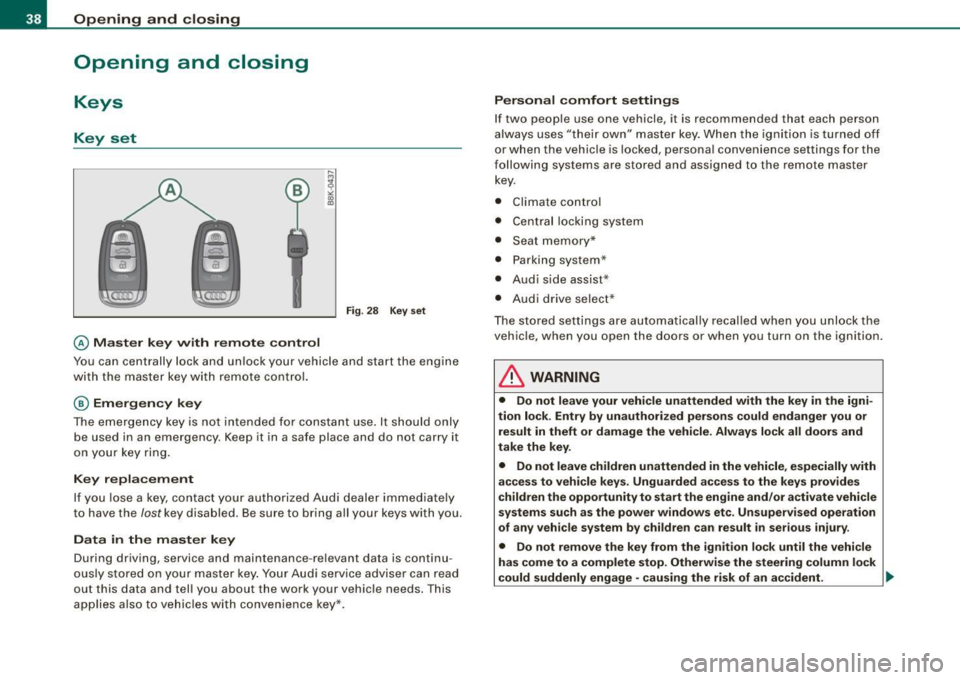
Opening and closing
Opening and closing
Keys
Key set
@ Ma ster key wi th remote control
Fi g. 28 Key set
You can centrally lock and unlock your vehicle and start the engine
with the master key with remote control.
@ Em erg ency key
The emergency key is not in tended for constant use . It sho uld only
be used in an emergency . Keep it in a safe place and do not carry it
on your key ring.
K ey repl aceme nt
If you lose a key, contact your authori zed Audi dealer immed iate ly
to have the
lost key disabled . Be sure to bring all your keys with you.
D ata in the ma ster key
During driving, service and maintenance -re levant data is continu
ously s tored on your master key . Your Audi service adviser can read
out this data and tel l you about the work your vehic le needs. This
applies als o to vehic les with convenience key*.
P ersonal comf ort settings
If two peop le use one vehicle, it is recommended that each person
always uses "their own" master key. When the igni tion is turned off
or when the vehicle is locked, persona l convenience settings for the
f ollowi ng sys tems are store d and assigned to the remot e master
key.
• Climate control
• Centra l locking system
• Seat me mory*
• Parking system *
• Audi side assist*
• Audi drive se lect*
T he stored setti ngs are automatically recalled when you unlock the
vehic le, when you open the doors or when you turn on the ignition.
& WARNING
• Do not leave your vehicle unattended with the key in the igni
tion lock . Entry by unauthorized per sons co uld end anger you or
result in theft or damage th e vehicle . Alway s lock all doors and
take the key .
• Do not leave children unattended in the vehicle , especiall y with
acce ss to vehi cle key s. Unguarded access to the key s prov ide s
children the opportunity to start th e engine and /or a ctivate vehicle
sys tem s such as the po wer windo ws et c. Un supervi sed oper ation
of any v ehi cle system by children can result in serio us injur y.
• Do not remove the key from the ig nition lock until the vehicle
ha s com e to a complete s top. Otherwi se the steering column lock
could suddenly engage -cau sing the ri sk of an accident. .,
Page 71 of 360
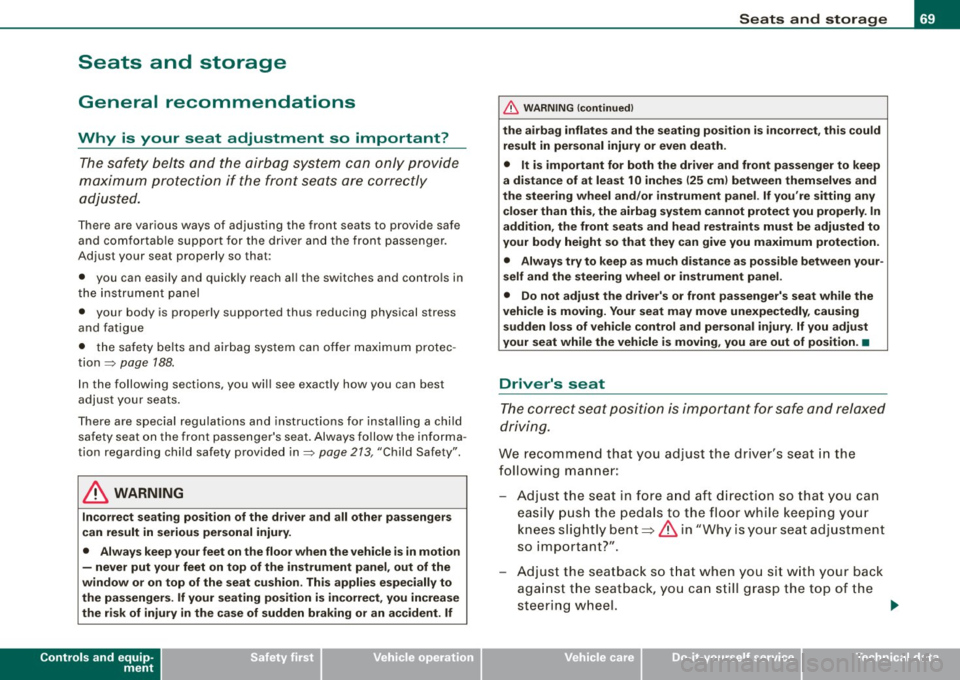
Seats and storage
General recommendations
Why is your seat adjustment so important? The safety belts and the airbag system can only provide
maximum protection if the front seats are correctly
adjusted.
The re are various ways of adjusting the front seats to provide safe
and comfortable support for the driver and the front passenger.
Adjust your seat properly so that:
• you can easily and quickly reach all the switches and controls in
the instrument panel
• your body is properly supported thus reducing physical stress
and fatigue
• the safety belts and airbag system can offer maximum protec
tion
~ page 188.
In the follow ing sections, you will see exactly how you can best
adjust your seats.
There are special regulations and instructions for installing a child safety seat on the front passenger's seat. Always follow the informa
tion regarding child safety provided in~
page 213, "C hild Safety".
& WARNING
Incorrect seating position of the driver and all other passengers
can result in serious personal injury.
• Always keep your feet on the floor when the vehicle is in motion
- never put your feet on top of the instrument panel, out of the
window or on top of the seat cushion. This applies especially to
the passengers. If your seating position is incorrect, you increase
the risk of injury in the case of sudden braking or an accident. If
Controls and equip
ment
Seats and storage
& WARNING (continued)
the airbag inflates and the seating position is incorrect, this could
result in personal injury or even death.
• It is important for both the driver and front passenger to keep
a distance of at least 10 inches (25 cml between themselves and
the steering wheel and/or instrument panel. If you're sitting any closer than this, the airbag system cannot protect you properly. In
addition, the front seats and head restraints must be adjusted to
your body height so that they can give you maximum protection.
• Always try to keep as much distance as possible between your
self and the steering wheel or instrument panel.
• Do not adjust the driver's or front passenger's seat while the
vehicle is moving. Your seat may move unexpectedly, causing
sudden loss of vehicle control and personal injury . If you adjust
your seat while the vehicle is moving, you are out of position. •
Driver's seat
The correct seat position is important for safe and relaxed
driving.
We recommend that you adjust the driver's seat in the
following manner:
Adjust the seat in fore and aft direction so that you can
easily push the pedals to the floor while keeping your
knees slightly bent=>
& in "Why is your seat adjustment
so important?".
- Adjust the seatback so that when you sit with your back
against the seatback, you can still grasp the top of the
steering wheel. ..,
I • •
Page 75 of 360
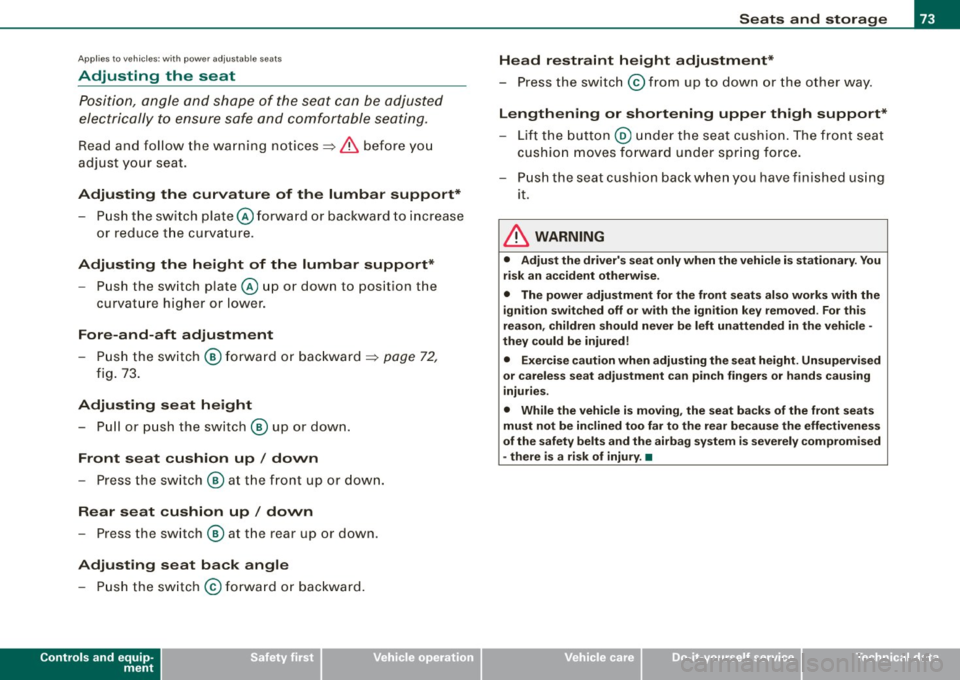
Applies to vehicles: w it h p ow er adju stable seats
Adjusting the seat
Position, angle and shape of the seat can be adjusted
electrically to ensure safe and comfortable seating.
Read and follow the warning notices~ & before you
adjust your seat.
Adjusting the curvature of the lumbar support* - Push the switch plate@forward or backward to increase
or reduce the curvature.
Adjusting the height of the lumbar support*
- Push the switch plate@ up or down to position the
curvature higher or lower.
Fore-and-aft adjustment
-Push the switch @ forward or backward ~ page 72,
fig. 73.
Adjusting seat height - Pull or push the switch @ up or down.
Front seat cushion up/ down
- Press the switch@ at the front up or down.
Rear seat cushion up / down
- Press the switch @ at the rear up or down.
Adjusting seat back angle - Push the switch @ forward or backward.
Controls and equip
ment
Seats and storage
Head restraint height adjustment*
- Press the switch @ from up to down or the other way .
Lengthening or shortening upper thigh support*
- Lift the button@ under the seat cushion. The front seat
cushion moves forward under spring force.
- Push the seat cush ion back when you have fin ished using
it.
& WARNING
• Adjust the driver's seat only when the vehicle is stationary. You
risk an accident otherwise.
• The power adjustment for the front seats also works with the
ignition switched off or with the ignition key removed . For this
reason, children should never be left unattended in the vehicle -
they could be injured!
• Exercise caution when adjusting the seat height. Unsupervised
or careless seat adjustment can pinch fingers or hands causing
injuries.
• While the vehicle is moving, the seat backs of the front seats
must not be inclined too far to the rear because the effectiveness
of the safety belts and the airbag system is severely compromised
- there is a risk of injury. •
I • •
Page 90 of 360
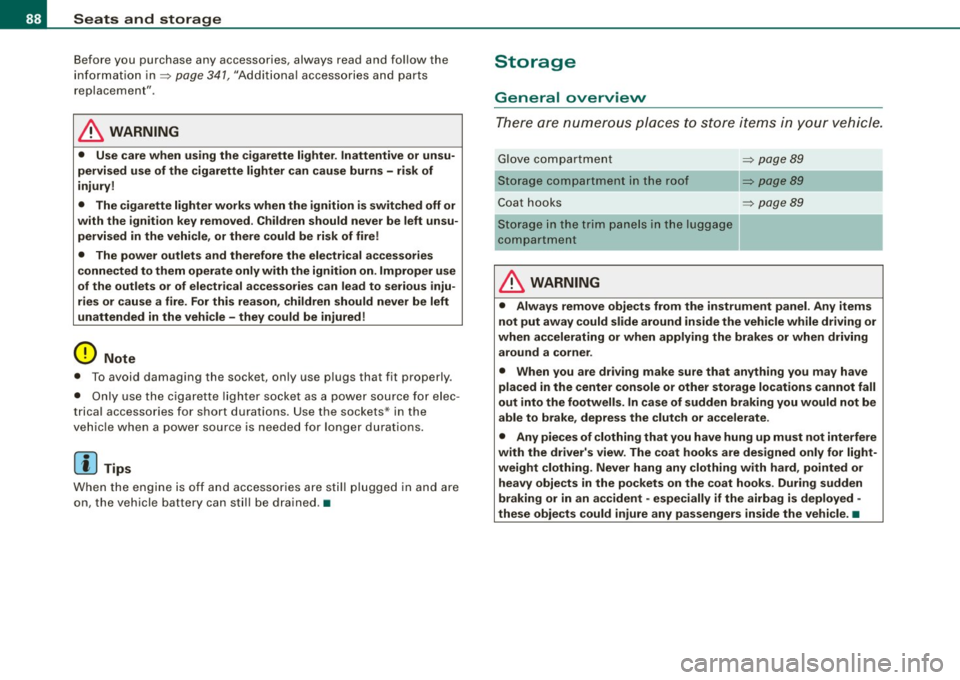
Seats and storage
Before you purchase any accessories, always read and follow the
information in=> page 341, "Additional accessories and parts
replacement".
& WARNING
• Use care when using the cigarette lighter. Inattentive or unsu
pervised use of the cigarette lighter can cause burns -risk of
injury!
• The cigarette lighter works when the ignition is switched off or
with the ignition key removed . Children should never be left unsu
pervised in the vehicle, or there could be risk of fire!
• The power outlets and therefore the electrical accessories
connected to them operate only with the ignition on. Improper use
of the outlets or of electrical accessories can lead to serious inju
ries or cause a fire. For this reason, children should never be left
unattended in the vehicle -they could be injured!
0 Note
• To avoid damaging the socket, only use plugs that fit properly .
• Only use the cigarette lighter socket as a power source for elec
trical accessories for short durations . Use the sockets* in the
vehicle when a power source is needed for longer durations.
[ i] Tips
When the engine is off and accessories are still plugged in and are
on, the vehicle battery can still be drained .•
Storage
General overview
There are numerous places to store items in your vehicle.
Glove compartment => page 89
Storage compartment in the roof =>
page 89
Coat hooks => page 89
- -Storage in the trim panels in the luggage
compartment
& WARNING
• Always remove objects from the instrument panel. Any items
not put away could slide around inside the vehicle while driving or
when accelerating or when applying the brakes or when driving around a corner .
• When you are driving make sure that anything you may have
placed in the center console or other storage locations cannot fall
out into the footwells. In case of sudden braking you would not be
able to brake, depress the clutch or accelerate.
• Any pieces of clothing that you have hung up must not interfere
with the driver's view. The coat hooks are designed only for light
weight clothing. Never hang any clothing with hard, pointed or
heavy objects in the pockets on the coat hooks . During sudden
braking or in an accident - especially if the airbag is deployed -
these objects could injure any passengers inside the vehicle . •
Page 170 of 360
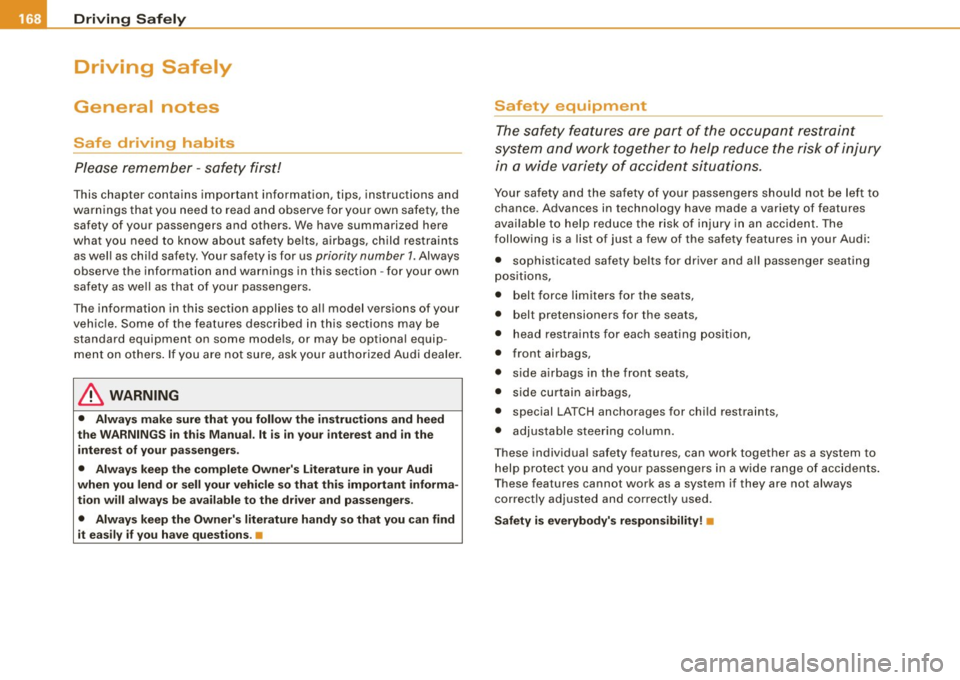
___ o_ r_iv _ i _n....; g::;_ S_ a_f _e _ly=-- -------------------------------------------------
Driving Safely
General notes
Safe driving habits
Please remember -safety first!
This chapter contains important information, tips, instructions and
warnings that you need to read and observe for your own safety, the
safety of your passengers and others. We have summarized here
what you need to know about safety belts, airbags, child restraints
as well as child safety. Your safety is for us
priority number 1. Always
observe the information and warnings in this section -for your own
safety as well as that of your passengers.
The information in this section applies to all model versions of your
vehicle. Some of the features described in this sections may be
standard equipment on some models, or may be optional equip
ment on others. If you are not sure, ask your authorized Audi dealer.
& WARNING
• Always make sure that you follow the instructions and heed
the WARNINGS in this Manual. It is in your interest and in the
interest of your passengers.
• Always keep the complete Owner's Literature in your Audi
when you lend or sell your vehicle so that this important informa
tion will always be available to the driver and passengers.
• Always keep the Owner's literature handy so that you can find
it easily if you have questions .•
Safety equipment
The safety features are part of the occupant restraint
system and work together to help reduce the risk of injury
in a wide variety of accident situations.
Your safety and the safety of your passengers should not be left to
chance. Advances in technology have made a variety of features
available to help reduce the risk of injury in an accident. The
following is a list of just a few of the safety features in your Audi:
• sophisticated safety belts for driver and all passenger seating
positions,
• belt force limiters for the seats,
• belt pretensioners for the seats,
• head restraints for each seating position,
• front airbags,
• side airbags in the front seats,
• side curtain airbags,
• special LATCH anchorages for child restraints,
• adjustable steering column.
These individual safety features, can work together as a system to
help protect you and your passengers in a wide range of accidents.
These features cannot work as a system if they are not always
correctly adjusted and correctly used.
Safety is everybody's responsibility! •
Page 171 of 360

________________________________________________ D_r_iv _ i _n_ g~ S_ a_ fe_ ly __ BI
Important things to do before driving
Safety is everybody's job! Vehicle and occupant safety
always depends on the informed and careful driver.
For your safety and the safety of your passengers, before
driving always:
-Make sure that all lights and signals are operat ing
correctly.
- Make sure that the tire pressure is correct.
- Make sure that all windows are clean and afford good
visibility to the outside.
- Secure all luggage and other items carefully =>
page 88.
-Make sure that noth ing can interfere w ith the pedals.
- Adjust front seat, head restraint and mirrors correctly for your height .
- Instruct passengers to adjust the head restraints
according to their height.
- Make sure to use the right ch ild restraint correctly to
protect children =>
page 213, "Child Safety ".
- Sit properly in your seat and make sure that your passen
gers do the same=>
page 69, "General recommenda
tions".
- Fasten your safety belt and wear it p roperly. Also instruct
your passengers to fasten the ir safety belts properly
=>
page 179. •
Controls and equip
ment Safety first
Vehicle operation
What impairs driving safety?
Safe driving is directly related to the condition of the
vehicle, the driver as well as the driver's ability to concen
trate on the road without being distracted.
The driver is responsible for the safety of the vehicle and all
of its occupants. If your ability to drive is impaired, safety
risks for everybody in the vehicle increase and you also
become a hazard to everyone else on the road =>& .There
fore:
Do not let yourself be distracted by passengers or by
using a cellular telephone .
NEVER drive when your driving ability is impaired (by
medications, alcohol, drugs, etc.).
- Observe all traffic laws, rules of the road and speed limits
and plain common sense .
- ALWAYS adjust your speed to road, traffic and weather
conditions.
- Take frequent breaks on long trips. Do not drive for more
than two hours at a stretch.
- Do NOT drive when you are tired, under pressure or when
you are stressed .
& WARNING
Impaired driving safety increases the risk of serious personal
injury and death whenever a vehicle is being used. •
Vehicle care Do-it-yourself service Technical data
Page 173 of 360

Driving Safely -
----------------
& WARNING (continued)
to help reduce the risk of personal injury if the driver's airbag
inflates.
• Never hold the steering wheel at the 12 o'clock position or with
your hands at other positions inside the steering wheel rim or on
the steering wheel hub . Holding the steering wheel the wrong way
can cause serious injuries to the hands, arms and head if the
driver's airbag deploys .
• Pointing the steering wheel toward your face decreases the
ability of the supplemental driver's airbag to protect you in a colli
sion.
• Always sit in an upright position and never lean against or
place any part of your body too close to the area where the airbags
are located .
• Before driving, always adjust the front seats and head
restraints properly and make sure that all passengers are properly
restrained.
• Never adjust the seats while the vehicle is moving. Your seat
may move unexpectedly and you could lose control of the vehicle.
• Never drive with the backrest reclined or tilted far back! The
farther the backrests are tilted back, the greater the risk of injury
due to incorrect positioning of the safety belt and improper
seating position.
• Children must always ride in child safety seats
=> page 213.
Special precautions apply when installing a child safety seat on
the front passenger seat
=> page 188 . •
Controls and equip
ment Safety first Vehicle operation
Proper seating position for the front
passenger
The proper front passenger seating position is important
for safe, relaxed driving.
For your own safety and to reduce the risk of injury in the
event of an accident, we recommend that you adjust the
seat for the front passenger to the following pos ition:
- Move the front passenger seat back as far as possible.
There must be a minimum of 10 inches (25 cm) between
the breastbone and the instrument panel
=> &.
- Adjust the angle of the seatback so that it is in an upright
position and your back comes in full contact with it
whenever the vehicle is moving.
- Adjust the head restraint so that the upper edge is as
even with the top of your head as possible but not lower
than eye level and so that it is as close to the back of your
head as possible .
- Keep both feet flat on the floor in front of the front
passenger seat.
- Fasten and wear safety belts correctly =>
page 183.
For detailed information on how to adjust the front passenger's
seat, see
=> page 69.
& WARNING
Front seat passengers who are unbelted, out of position or too
close to the airbag can be seriously injured or killed by the airbag
as it unfolds. To help reduce the risk of serious personal injury : .,
Vehicle care Do-it-yourself service Technical data
Page 174 of 360

-Driving
Safely ------=-------=----------------
& WARNING
(continued)
• Passengers must always sit in an upright position and never
lean against or place any part of their body too close to the area
where the airbags are located.
• Passengers who are unbelted, out of position or too close to the
airbag can be seriously injured by an airbag as it unfolds with
great force in the blink of an eye .
• Always make sure that there are at least 10 inches (25 cm)
between the front passenger's breastbone and the instrument
panel.
• Each passenger must always sit on a seat of their own and
properly fasten and wear the safety belt belonging to that seat.
• Before driving, always adjust the front passenger seat and
head restraint properly.
• Always keep your feet on the floor in front of the seat . Never
rest them on the seat, instrument panel, out of the window, etc.
The airbag system and safety belt will not be able to protect you properly and can even increase the risk of injury in a crash.
• Never drive with the backrest reclined or tilted far back! The
farther the backrests are tilted back, the greater the risk of injury due to incorrect positioning of the safety belt and improper
seating position.
• Children must always ride in child safety seats~
page 213.
Special precautions apply when installing a child safety seat on
the front passenger seat
~ page 188 . •
Proper seating positions for passengers in
rear seats
Rear seat passengers must sit upright with both feet on
the floor consistent with their physical size and be prop
erly restrained whenever the vehicle is in use.
To reduce the risk of injury caused by an incorrect seating
position in the event of a sudden braking maneuver or an
accident, your passengers on the rear bench seat must
always observe the following:
- Make sure that the seatback is securely latched in the
upright position~
page 80.
Keep both feet flat in the footwell in front of the rear seat.
Fasten and wear safety belts properly ~
page 183.
-Make sure that children are always properly restrained in
a child restraint that is appropriate for their size and age
~ page 213.
& WARNING
Passengers who are improperly seated on the rear seat can be
seriously injured in a crash.
• Each passenger must always sit on a seat of their own and
properly fasten and wear the safety belt belonging to that seat.
• Safety belts only offer maximum protection when the seatback
is securely latched in the upright position and the safety belts are
properly positioned on the body . By not sitting upright, a rear seat
passenger increases the risk of personal injury from improperly
positioned safety belts!
• Always adjust the head restraint properly so that it can give
maximum protection . •
Page 175 of 360

Driving Safely ---------------=------------'-
Proper adjustment of head restraints
Correctly adjusted head restraints are an important part
of your vehicle's occupant restraint system and can help
to reduce the risk of injuries in accident situations.
Fig. 182 Correctly
adjusted head restraint
viewed from the side
The head restraints must be correctly adjusted to achieve
the best protection.
-Adjust the head restraint so that the upper edge of the
restraint is level with the top of your head, but no lower
than eye level and so it is as close to the back of your
head as possible ~
page 173, fig. 182.
Adjusting head restraints=> page 76.
& WARNING
Driving without head restraints or with improperly adjusted head
restraints increases the risk of serious injuries in a collision . To
help reduce the risk of injury :
• Always drive with the head restraints in place and properly
adjusted.
• Every person in the vehicle must have a properly adjusted head
restraint.
Controls and equip ment Safety first Vehicle operation
& WARNING (continued)
•
Always make sure each person in the vehicle properly adjusts
their head restraint. Each head restraint must be adjusted
according to occupants' size so that the upper edge is as even
with the top of the person's head, but no lower than eye level and
so it is as close to the back of to the head as possible .
• Never attempt to adjust head restraint while driving. If you
have driven off and must adjust the driver headrest for any reason,
first stop the vehicle safely before attempting to adjust the head
restraint.
• Children must always be properly restrained in a child restraint
that is appropriate for their age and size=>
page 213. •
Examples of improper seating positions
The occupant restraint system can only reduce the risk of
injury if vehicle occupants ore properly seated.
Improper seating positions can cause serious injury or
death . Safety belts can only work when they are properly
positioned on the body. Improper seating positions reduce
the effectiveness of safety belts and will even increase the
risk of injury and death by moving the safety belt to critical
areas of the body. Improper seating positions also increase
the risk of serious injury and death when an airbag deploys
and strikes an occupant who is not in the proper seating
position. A driver is responsible for the safety of all vehicle
occupants and especially for children. Therefore:
- Never allow anyone to assume an incorrect seating posi
tion when the vehicle is being used~& .
The following bulletins list only some sample positions that will
increase the risk of serious injury and death. Our hope is that these .,_
Vehicle care Do-it-yourself service Technical data